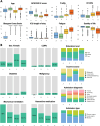Identifying distinct clusters of ICU survivors by integrating demographic, pre-admission quality of life, and clinical data: a large prospective cohort study
- PMID: 40773138
- PMCID: PMC12405309
- DOI: 10.1007/s00134-025-08052-3
Identifying distinct clusters of ICU survivors by integrating demographic, pre-admission quality of life, and clinical data: a large prospective cohort study
Abstract
Purpose: ICU patients differ in pre-ICU health status, comorbidities, and diagnosis, forming a heterogeneous population with diverse long-term outcomes. This study explored whether clustering ICU patients by demographic, pre-admission quality of life, and clinical data, rather than by diagnosis, could identify subgroups that are more informative for patient-centered outcomes post-ICU.
Methods: Data from the MONITOR-IC prospective cohort study were used. Demographic, pre-admission quality of life, and clinical data from 2361 adult ICU survivors of six hospitals were used to identify clusters, using the k-prototypes algorithm. Data from five additional hospitals (n = 866) were used for external validation. Self-reported physical, mental, and cognitive functioning, and quality of life one year post-ICU were described.
Results: The four identified clusters differed significantly in long-term physical, mental, and cognitive functioning, and quality of life. Cluster-A (n = 204), characterized by a healthy pre-ICU status, high disease severity, low Glasgow Coma Scale, and long ICU stay, had a relatively high quality of life at one year, despite experiencing a mean decline from baseline. Cluster-B (n = 877), also a healthy group before admission but less severely ill at ICU admission, reported the best outcomes. Cluster-C (n = 632) included younger, mostly female patients with moderate impairments both pre- and one-year post-ICU. Cluster-D (n = 648), characterized by a low education level and poor baseline health, reported impaired outcomes one year post-ICU, although improved compared to their pre-admission status. External validation confirmed the generalizability of these results.
Conclusion: This study identified and externally validated four distinct clusters of ICU patients by integrating both clinical and non-clinical data. These clusters, which differed in long-term physical, mental, and cognitive outcomes, challenge conventional disease-based classification, and support a multidimensional approach to define subgroups of ICU patients.
Trial registration: The MONITOR-IC study was registered at ClinicalTrials.gov: NCT03246334.
Keywords: Cluster analysis; Critical care outcomes; Health status; Quality of life.
© 2025. The Author(s).
Conflict of interest statement
Declarations. Conflicts of interest: None of the authors have competing interests to declare. Consent to participate: Informed consent was obtained from all individual participants included in this study. Institutional Review Board approval: The MONITOR-IC study (ClinicalTrials.gov: NCT03246334) was approved on August 23rd, 2016, by the local ethics committee of the Radboud University Medical Center, CMO region Arnhem-Nijmegen, the Netherlands (2016-2724).
Figures




References
-
- Porter LL, Simons KS, Ramjith J, Corsten S, Westerhof B, Rettig TCD, Ewalds E, Janssen I, van der Hoeven JG, van den Boogaard M, Zegers M (2023) Development and external validation of a prediction model for quality of life of ICU survivors: a subanalysis of the MONITOR-IC prospective cohort study. Crit Care Med 51:632–641. 10.1097/CCM.0000000000005800 - PubMed
-
- Fernandez MV, Serrano-Gomez C (2023) Measuring quality of life. What are we missing? Crit Care Med 51:e244–e245. 10.1097/CCM.0000000000005957 - PubMed
-
- Soliman IW, de Lange DW, Peelen LM, Cremer OL, Slooter AJ, Pasma W, Kesecioglu J, van Dijk D (2015) Single-center large-cohort study into quality of life in Dutch intensive care unit subgroups, 1 year after admission, using EuroQoL EQ-6D-3L. J Crit Care 30:181–186. 10.1016/j.jcrc.2014.09.009 - PubMed
Publication types
MeSH terms
Associated data
LinkOut - more resources
Full Text Sources
Medical

